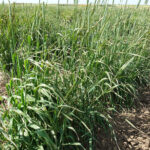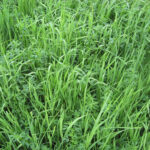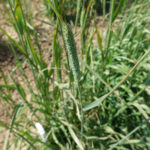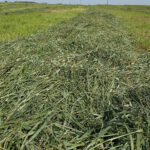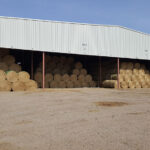Timothy
Phleum pratense
General Description
Timothy is a widely adapted, cool season perennial bunchgrass. It is best adapted to cooler, higher rainfall regions or wetter areas. It is considered hardy and reliable, but does not tolerate drought well. Timothy persists in a stand long-term through self seeding and seedling establishment.
Timothy roots are wide spreading, shallow and fibrous with heaviest concentration of roots within top 7.5 cm (3 in) of soil. Swollen bulbs or corms develop just below the surface and store nutrients for winter survival and regrowth after cutting or grazing. Timothy has strong tall stems up to 120 cm (47 in) tall. Leaves are hairless and rolled during the bud stage. They are relatively wide, up to 12 mm, and flat. The seed head is a spike of densely packed, bristle-like spikelets, each producing a tiny, dark brown seed.
Type
Tame grass.
Origin
Europe. Most varieties used in Canada come from American breeders.
Longevity
At least 5 years to 10 years depending on the location and management. Within the Peace River Region, timothy is considered a very long-lived grass with stands 20 years old.
10+ years depending on the location and management.
Use
Pasture, hay. In the Peace River Region timothy is also used for stockpiled grazing due to its high adaptability in the region. There is a select timothy hay export and pet food market that continues to grow.
Pasture, hay, silage, stockpiled grazing. There is a select timothy hay export and pet food market that continues to grow.
Optimal Time of Use
Summer; some fall use soil zone dependant. Hay the first cut between the headed and blooming. Second cut of a lower yield may be taken or regrowth may be grazed. Timothy is often grazed early in summer for most livestock but graze after stem elongation. Growth slows later in the summer but can be lightly re-grazed. Once the plant is dormant, timothy stands can be grazed in late fall and winter, but it does not hold its feed quality.
Recovery After Use
Requires a minimum 60-80 days of recovery after use. Timothy responds best to a full season of rest in the black soil zone (used once). Leave at least 10 cm (4 in) of grassy residue to aid in regrowth. Timothy regrows slowly if cut or grazed in late summer. Because timothy is not sod producing, it is intolerant of grazing hoof damage. Fall grazing should be light as nutrient reserves are accumulated in the corms (root bulbs) for winter.
Leave at least 10 cm (4 in) of grassy residue to aid in regrowth. Timothy regrows slowly if cut or grazed in late summer. Because timothy is not sod producing, it is intolerant of grazing hoof damage. Fall grazing should be light as nutrient reserves are accumulated in the corms (root bulbs) for winter.
Palatability/Nutritional Value
If used early in the season before flowering, timothy has good quality, 11% crude protein, and 61% digestibility. Timothy pasture is very palatable in the vegetative stage. At later growth stages, quality and nutritional value decline rapidly. Overall, a highly palatable and preferred species for cattle and horses.
Annual Precipitation min/max (mm)
400mm / 1650mm
Drought Tolerance
Generally poor drought tolerance. Although some varieties have some drought hardiness, most timothy cannot tolerate short periods of moisture stress.
Flooding Tolerance
Withstands 2-5 weeks of spring flooding. There are differing views in the literature on its tolerance to flooding later in the growing season. Timothy does grow well on moister soils.
Winter Hardiness
Good to excellent tolerance. Winter hardiness is enhanced with adequate snow cover.
Soil Texture Preference
Timothy is well adapted for all soil textures when moisture is plentiful (Grey or Black soils).
Erosion Control
Moderate erosion control. Timothy is noted for use in wetland upland areas when seeded with other species.
Salinity Tolerance
Not tolerant.
Acidity Tolerance
High tolerance. Timothy tolerates soil pH as low as 4.5.
Alkalinity Tolerance
Low tolerance.
Seeds per kg
2,564,000 seeds/kg (1,163,000 seeds/lb)
Suggested Mixtures
Timothy is often grown as a pure stand for premium hay. It can be seeded in a mix with legumes such as alfalfa, alsike clover, red clover or birdsfoot trefoil. In the Peace River Region, timothy is usually include it in most mixes at 5-10% as it establishes very well in the low wet spots of the field.
Timothy is often grown as a pure stand for premium hay. It can be seeded in a mix with legumes such as alfalfa, alsike clover, red clover or birdsfoot trefoil.
Ease of Establishment
The small seeds of timothy must be seeded shallow for establishment. Timothy is relatively easy to establish early in the spring. Heat and drought will cause seedlings to die.
Competitiveness
Poor to moderate competitiveness while establishing so weeds must be managed. Timothy has moderate competitiveness once established. Timothy can co-exist with native species where it is well adapted, but it generally is not considered invasive.
Management Considerations
Drought tolerance is the major limitation with timothy. Timothy responds positively to fertilization. Allow timothy to drop seed occassionally to increase stand longevity. Timothy is best rotationally grazed but can be difficult to manage to not graze too early or during stem elongation and to consider that regrowth potential is low.
British Columbia Rangeland Seeding Manual, Saskatchewan Dryland Forage Species Adaptation Tool, USDA Plants Database, Manitoba Forage Adaptation and Comparison Guide, Alberta Forage Manual, Publication 30-OMAFRA
Timothy is adapted to the Sub-Boreal Spruce, Sub-Boreal Pine-Spruce and Interior Cedar-Hemlock zones. In the southern part of the Central Interior region, it is adapted to wetter parts of the Interior Douglas-fir zone and to irrigated and subirrigated areas in the Bunchgrass zone and drier parts of the Interior Douglas-fir zone.
Timothy is adapted to the wetter parts of the Interior Douglas-fir zone and the Interior Cedar-Hemlock zone, and to irrigated and subirrigated areas in the Bunchgrass, Ponderosa Pine zones and drier parts of the Interior Douglas-fir zone.
Some timothy stands managed for seed production in the Peace-Liard region have been established for 18 years or more.
